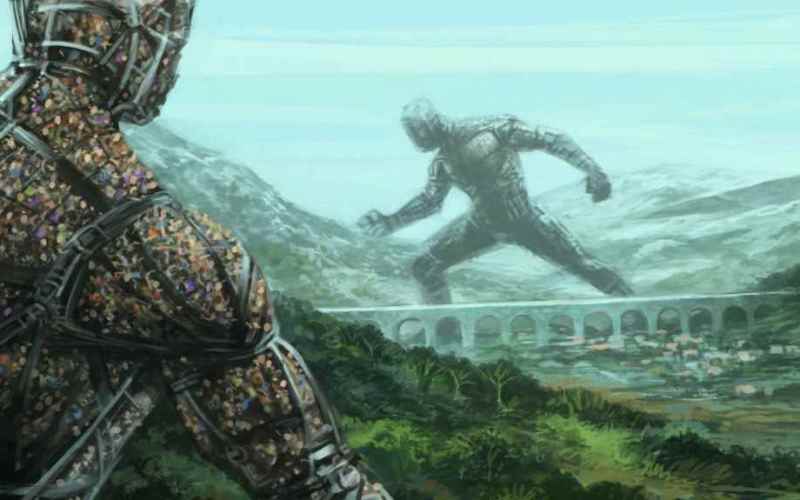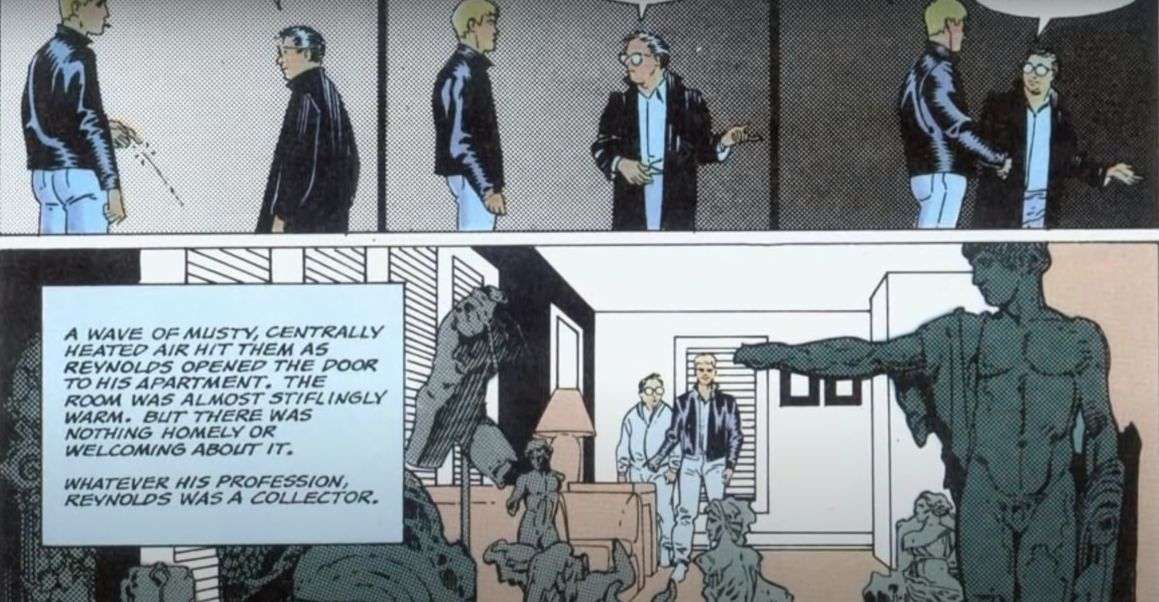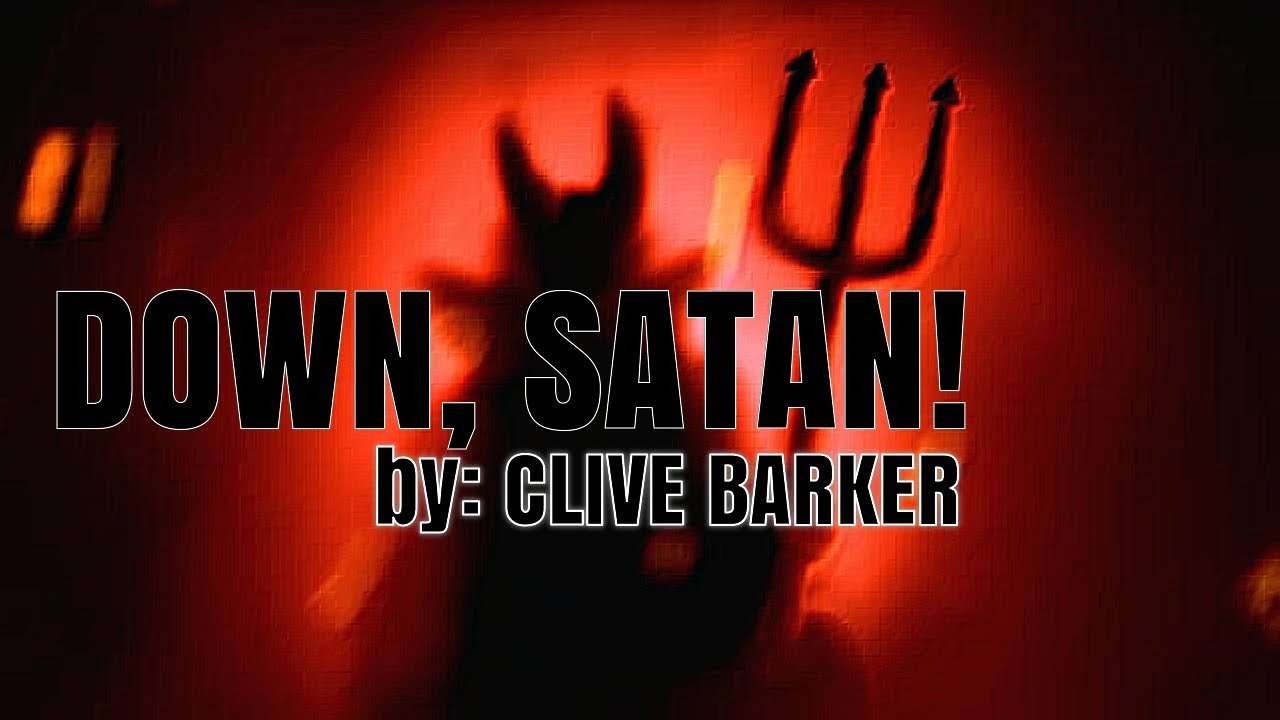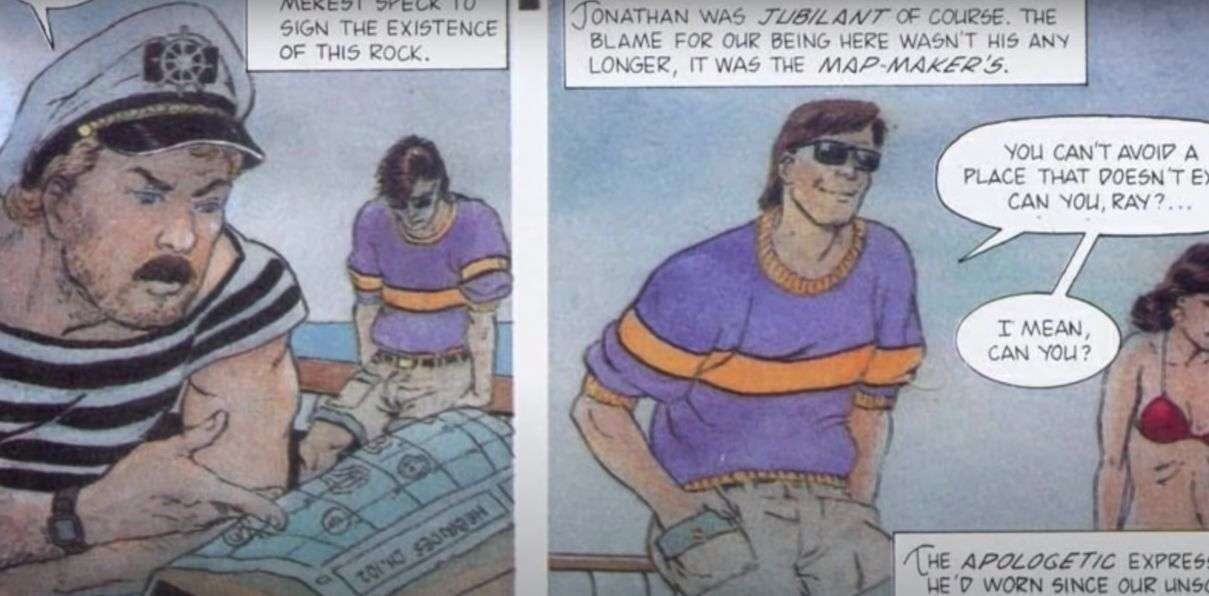Clive Barker, an English playwright, author, and director, has built a reputation for himself in the horror genre after making substantial contributions to it since the 1980s. Barker transitioned from writing stage plays to writing books, with his most well-known work being the six-part collection novel Books of Blood.
Each book comprises four to five horror stories that have been converted into films and television on multiple occasions, with the most recent adaption airing on Hulu in 2020. Books of Blood has brought Barker more recognition than any of his previous books, because to its notorious slogan “Everyone is a book of blood; wherever we’re opened, we’re red.”
When a fake psychic is visited by real ghosts and spirits one night, he begins writing their stories on his flesh, transforming him into a true medium between the living and the dead. These stories turn him into a literal “Book of Blood,” and readers will be able to read each of them over the course of the book’s six volumes. ”
The Books of Blood” is the title of the first three volumes, “The Inhuman Collection” is the title of the fourth book, “In the Flesh” is the title of the fifth volume, and “Cabal” is the title of the last and sixth volume.
Today, we’ll go into eight distinct stories from all of the books’ volumes and examine them in depth.
In the Hills, the Cities (Vol. 1)

‘In the Hills, the Cities,’ set in the tense political climate of the Soviet Union in the 1980s, follows the journey of a gay couple, Mick and Judd, as they travel through Western Europe and try to figure out their relationship, the bigger picture, and the collapsing world around them as the line between reality and fiction blurs.
Judd and Mick go around Yugoslavia at a time when two cities, Popolac and Podujevo, are holding a ten-year-old ceremonial celebration. But they have no idea that things are about to go berserk this year.
While driving, the two discuss how much they despise one other. While Mick is irritated with Judd’s inevitable habit of politicising every aspect of life and lecturing without end on topics that Mick thinks are boring, Judd thinks about how uninterested Mick is in all things that one should pay close attention to. Judd thinks of Mick as someone too idealistic and carefree in a world that is clearly going through big changes that need to be acknowledged.
Finally, the two get into a spat and although Judd seems insistent on arguing, Mick tries his best to give him the satisfaction of the same. The two decide to put a temporary stop to their fighting by making love in a spontaneous moment after Mick makes Judd get out of the car in the middle of nowhere. Meanwhile the contest between Popolac and Podujevo takes place and the people of both the towns tie themselves to each other to form two giants.
The town that is able to create the more majestic giant usually wins the competition, but something goes horribly wrong. Some of the people trip, forcing the Podujevo behemoth to fall completely, resulting in the deaths of all 38,765 citizens.
It’s enough to drive the residents of Popolac nuts when the Popolac monster saunters in as the tall skyscraper it had created itself to be and sees the vast number of dead victims all twisted up and tied together.
Having lost their sanity, in a bizarre turn of events, the citizens of Popolac develop a collective conscience and disregard their individuality. This causes them to literally turn into one big giant and act like one mind that walks around aimlessly till the citizens start droppingdead one after the other fromthe lack of food and dehydration.
But despite the loss of so many people, the Popolac giant continues to walk. A local recounts what happened to the Podujevo giant when Mick and Judd come across the massacre, but the incredible nature of the disaster makes it difficult for the young men to accept.
While Mick and Judd seek refuge with an elderly couple, a local man tries to take their automobile so that he might pursue the Popolac giant and possibly prevent the surviving citizens from suffering agonising and horrific deaths.
The Popolac giant arrives while they are there, and as more people die, the frail’giant’ topples over the shelter, accidentally murdering Judd.. This causes him, as well as the elderly couple they took shelter with, to go insane. The story ends with Mick climbing atop the Popolac giant and merging with the collective conscience as he is carried away atop the hills.
The concept of Barker’s story is unique and is often seen in comparison to the broad line of work of the widely celebrated MangakaJunji Ito. This is because Ito is known for the deeply disturbing imagery he uses to portray the twisted reality of our world, as Barker has done in In the Hills, the Cities.
The idea of individuality being lost screams at us to draw more attention to the importance of individual identity and how it isimperative for people in a society to not ‘lose it’. It is easy for us to become one with the norm and that has been happening everywhere in the world as a part of the larger scheme such as politics as well as the smaller schemes such as household “traditions”.
Not many are able to question the norm, the authority or stand up to it and this story is a bizarre yet horrifying exaggeration of the implications thatit can have on us, or rather already has on us.
Skins of the Fathers (Vol. 2)

The story begins with a man named Davidson, whose automobile breaks down somewhere in the Arizona desert, prompting him to search for someone who can assist him.
When Davidson hears music that makes him assume a carnival is taking place, he follows the sound and ends up near a parade of people marching through the desert. To his surprise, he realises that the people wearing what he thought were enormous hats were actually much taller than the normal human is supposed to be.
When Davidson sees this terrifying collection of enormous monsters, he is afraid and begins to flee when one of them charges towards him. However, the monster destroys Davidson’s car before it catches on fire, instead of attacking Davidson like he thought it woulddo.
This monster, like others of its kind has just one eye andhas mouths on its hands. After having disfigured some bit of its face trying to stop David’s car from exploding, the monster stumbles straight into the town of Welcome and collapses.
When panic ensues, one of the mouths on the monster’s hand ends up attacking the sheriff in response to which a woman named Eleanor shoots and kills the monster. In the same town, a family of threeis languished in pain, living a life of abuse.
The father, Eugene cannot stand his son Aaron and his wife Lucy, so he beats them up regularly after getting drunk. But the history of this family is more closely linked to the giants that have arrived in town than we think.
It is revealed in the backstory that in the beginning, there were only women who lived in peace and harmony, and that these ladies “made” men as their playthings. They quickly realise their error, however, because it is these same males who go on to dominate, abuse, and treat them as slaves.
These were the giants who paraded across the Arizona desert, and any man born after that was a result of the women’s efforts to repair their error and make men who were better human beings.
Six years prior to David arriving in Arizona, Lucy was raped by these monsters in the desert, leading to her conceiving Aaron. This explains the lack of connection Eugene feels towardshis son and when the monsters arrive, Aaron runs towards them calling them “Papa”. Sadly, Eugene kills Aaron when he sees him starting to transform into a monster.
This along with the town having formed a posse to fight the monsters enrages them. The creatures convert the entire desert town into quicksand, and just as the majority of the inhabitants have sunk below the surface, the ground solidifies, killing them and leaving those still trapped midway in agony.
Only David and Eleanor, as well as a weird man who happened to plunge head-first into the quicksand, are still stuck halfway above the surface. His eyes were buried in the dirt, but his nose and mouth continued to breathe.
Although Lucy survives, she knows there is no way that she can help them and so she simply runs away, leaving the three to be cooked alive when the desert sun comes up. This story of Barker seems like an attempt to rewrite the Genesis with the gender roles reversed butwith just as much violence.
He tries to shift the focus from women being created by men to men being created by women,which has been appreciated by several feminist critics. It has had its own set of backlash for the reason that it still advocates for violence against one gender and inequality rather than aiming for a utopia that will see both genders in equal respect.
Human Remains (Vol. 3)

This story centres around Gavin, a gay prostitute who is recruited by an archaeologist, and his feelings, or lack thereof. Gavin finds himself in need of the bathroom as the night passes and the two guys enjoy each other’s company. On entering, he notices a peculiar find: a statue of a guy that resembles a Roman figure in the archaeologist’s bath.
Gavin almost forgets about it since he doesn’t give it much attention, but in the weeks that follow, he is tormented by someone who looks exactly like him. The more this doppelganger haunts him, the more he notices his mind and body changing over time.
He becomes less emotional and his actions look more lifeless. His eyes look like they have nothing to see anymore and eventually he turns into a living dead, not requiring any of the things that humans do such as emotional stimulation, physical stimulation or even food or sleep.
One night, he walks to his father’s grave, while he is on the verge of losing the last bit of remaining humanity within him. It is here that he sees the same statue once again, except this time he knows who it is- the doppelganger that has been haunting him.
Despite knowing that he is now worse than a dead man, Gavin only sheds few tears but still feels unmoved. So much so that even the statue seems like it is livelier than Gavin is and with this realisation having dawned upon him, Gavin accepts his fate and allows his doppelganger statue to go on and live the life he cannot anymore.
Although the story initially appears strange and even impossible to comprehend, it quickly becomes evident that Gavin’s account is an exaggeration of how most sex workers actually live their lives. They go about their business without taking joy in it, and they discipline their thoughts to never become attached to anything or anyone.
Most of their clients find their lack of emotions and seeming humanity appealing, thus we may conclude that when the archaeologist first meets Gavin, he was already dead, and that with each client he serviced, Gavin got closer to becoming a zombie.. But he is finally able to rest in peace when he is sure that the statue will take on his persona and solidify his youth and beauty forever.
Down, Satan! (Vol. 4)

This story is one of Clive Barker’s shortest and has an enigmatic ending, yet it may be one of the reasons why it is one of his greatest. Down, Satan! is the storey of Gregorius, a guy who appears to be struggling with his religion until he reaches a point when he is helpless and depressed.
Tired of waiting for God to send him a sign, Gregorius resolves to establish his own Hell on Earth, which he will use to tempt Satan to follow him. He believes that after Satan’s wicked grips have encircled him, God will undoubtedly come in front of Gregorius to save His faith and dedication. As feared, things go awry once Gregoriu finishes the enormous cathedral consecrated to Satan.
Having lost track of what his initial intentions were, Gregorius now begins to enjoy being in the presence of evil. He tortures and executes many people in chambers that were specially designed and the story is left with an open-ending, leaving readers wondering if Satan did truly take over Gregorius or if the man’s mental illness simply drove him insane.
Either way, the story confirms for the protagonist that neither God nor Satan is real and that faith alone cannot save those that he chooses as his next victims of torture. Seeing how Barker himself is gayand might have struggled with his homosexual identity, it cannot be overlooked that he must have struggled with faith and the belief in God at some point in his own life as well. This story reflects that dilemma, although in a much more dramatized fashion than in reality.
Many individuals begin to doubt God’s existence, particularly in the face of danger and horror, and find it difficult to maintain their faith when they witness “God” allowing so many horrible things to happen in the world.
This novel swings closer towards dystopia, where the struggle for faith does not result in its restoration, but rather confirms that neither God nor Devil will be present to intervene in our mortal world, if they exist at all.
Stephen Master, widely regarded as the true king of the horror genre with works such as Carrie and The Shining, has lauded Barker’s work, saying, “I have glimpsed the future of horror… and its name is Barker.”
Hell’s Event

The narrative starts with some of the most heinous disclosures! Hell, it seems, has descended onto the streets of London, bringing with it a cold bitterness that even the sweltering Indian heat will not be able to mask. This arrival has a clear purpose, and we learn that an athletic event is about to begin.
It’s been going on for thousands of years, and hell’s contestants have always been fierce competitors. A race is about to start, and the pre-race commentary has already started. It’s being billed as a charity event with money benefiting cancer research, but it’s plainly about something else!
Frank Flash McCloud had earned a reputation of being one of the fastest in the circuit, and Joel was his tough competition. Joel was an Olympic Gold winner, and he was a courageous runner who believed in his skills and his good luck charm.
While the race was in progress, we are witness to something strange when Cameron follows a car into a building. Upon entering the place, there seems to be something strangely off about the place engulfed in a goat-like odour.
It is bitterly cold inside, and we learn that it isactually a bit of hell on Earth! One of the racers fall onthe track, and some hands seem to grab him from under the surface, unseen to the others. McCloud was leading with Joel in pursuit, but he was lagging behind.
A horrifying fact is exposed while all of this was going on the tracks. Gregory Burgess, a member of parliament, serves hell and is served by hell in return. He is doing their bidding to win the race against heaven, and if they succeed, humanity will perish.
Once every hundred years, such races take place, and the winner determines the fate of the entire globe. Cameron sees some horrific demons and desperately tries to get to the train tracks in time to warn the world about the approaching catastrophe.
One of the runners was on his way to hell, and treachery assured his victory. Joel surged ahead after McCloud collapsed at the end. Joel realizes the actual stakes of the race, and as the others fall, he keeps up his speed.
One of Hell’s runners bites his face off, but their struggle ensures that a human runner finishes the race, causing Hell to lose one more time. Gregory is brutally punished for his failure to make Hell win, and humanity is saved.
This amusing story is a rather comical allegory on politics, and using sports to stir up the fun is an innovative idea. Is there a slight hint here about democracy being a lot messier than what it seems to be?
It could be well implied, but for the major part of it, the elements of horror is less prominent in this story than in some of his other works. In short, the narrative is open to any two forms of opposing politics, and it is intentionally made comical and goofy.
London being a place of the hell uprising, and a race between heaven and hell is certainly quite unique! But we have to say that this story does not hold up to the high standards set by Clive Barker in hisother horrifying works.
How Spoilers Bleed

Locke is the cold-blooded head of a mercenary group from Europe. The story begins with him inspecting the South American jungles. He appears to be awestruck by the variety of nasty and beautiful creatures found in the woods, but he is not there to admire nature!
One of his coworkers, who is concerned about the fate of one of their coworkers, interrupts his thoughts. He has some bizarre sickness that no one can explain, and his skin breaks away at the touch of a finger.
His colleague is concerned that they may have contracted the disease from the native tribal people, but he is perplexed because they did not come into contact with any of them.
But Locke firmly dismisses the possibility that it is some curse. The narrative begins in present tense, and then we are drawn into the past to get an idea of what exactly is happening here! They arrived in this place, and thought that it was deserted, until they saw traces of the tribal people.
They were expressionless, and Locke could not understand their intentions. They were not being violent towards them, but their gaze wasn’t exactly friendly either. These tribal people clearly did not seem eager to move away from the place under any circumstances. It was their sacred land, and they simply did not understand the concept that their homeland wasnow owned by other people.
The indigenous continued to look back at Locke and his men with their expressionless features, despite Locke and his men making it obvious that they would have to leave. Because one of the tribal members could communicate in English, Locke informed them that they would have to leave the area.
They didn’t appear to care, and one of the men, infuriated, inadvertently kills a young boy. It wasn’t done on purpose, but there would be a cost! A curse is placed on them by a senior member of the tribe, and it results in a dreadful condition.
Their bodies had brittleened to the point that even a brisk breeze may cause catastrophic damage. A little touch might injure them, and the men began to die one by one. With time, Locke realized that it was nothing but the ancient curse, and only the tribe could now fix it.
However, when he returned to the same place to beg for forgiveness, a horrible sight awaited him. It seemed like one of his colleagues had killed them all, and now, there was no way to fix things. Even Locke seemed to be affected by the curse, and the story ends with this sense of helplessness and doom.
We loved the attention to the details in this story, and the comic version took it to another level with the vivid sketches. It is quite a bloody and gory story, so if you are averse to such elements, you might choose to give this a miss.
The tribal folk included in the novel were quite cool, and their cold, unapologetic demeanours were a little unsettling at times. It would have been lovely if they had a narrative, but we could see they were truly one with the environment.
It could have been a little longer with more explanations, and the characters could have been more than the obnoxious jerks that they were! Overall, it’s an engaging Clive Barker storey that you’ll find enjoyable to read.
Pig Blood Blues

The setting for this narrative is a children’s jail facility. Petty thieves and small-time criminals, on the other hand, are not welcome here. Only individuals who have committed major violent offences in the past are put here. We’re shown around the ostensibly harsh facility where the children must adhere to severe discipline.
Redman, a disgraced cop, is put in command of the institution, and he has no illusions about the inmates that are housed there. These weren’t your typical misled, misguided young minds; these were folks that kept razors under their tongue and simply wanted to be out and about, continuing their horrible activities.
A lady welcomes Redman to the facility, and tells him how some of the boys there are a bit too aggressive. They find it extremely hard to control themselves, and it becomes a big problem to manage them.
As they speak, a nasty fight breaks out, and Redman moves in to handle the defeated fellow. The young boy named Lacey is bashed up, and he needs immediate medical attention.
However, the very next day Redman finds out that something is amiss about the young fellow. He talks about some pig and desperately wants to get out of there, completely paranoid. Before he is whisked away, Lacey says something about Henessey being back.
We find that Henessey had vanished unexpectedly some time before, and that Lacey had some sort of link with him. Things did seem a little fishy to Redman, and he would soon become overly involved with the investigation. Even if they didn’t like Redman, the convicts treated him with respect.
They were well aware that he was not to be trifled with, and they acted accordingly. Redman, on the other hand, couldn’t get the case out of his head and proceeded to investigate a local sty. Before returning inside, he came across a weirdly hypnotising pig that seemed to stare him down.
Redman interrogates Lacey to gain some more information regarding the case, and he is shocked at what he reveals. Henessey had planned it all meticulously to live forever. He hanged himself, and made sure that his spirit would live within the pig forever.
His spirit possessed a large sow in the facility’s farm project, and kept haunting the place. Initially, Redman did not believe a word, but slowly he came to realize that Lacey wasn’t lying after all.
He finds out that the faculty, and some of the other boys are trying to feed Lacey to the giant pig, and the foul-play is pretty obvious. The investigations, don’t really lead to a happy ending for Redman as Lacey is eventually possessed by the spirit of a pig, and he eats him alive!
Simply because of the ridiculous aspects used in the story, this is not one of the easiest stories to describe. We consider this story to be one of Clive Barker’s hidden jewels, and while the narrative may seem absurd, the graphic novel will give you the chills.
It’s more of a mystery-thriller, and the stunning revelations came as a complete surprise. The amount of violence is exactly right, and it’s only until the climax that things turn really nasty. Redman is a heroic figure, and his tragic end will leave you speechless. The shocking conclusion is captivating, and we can assure you that this is a narrative that will captivate you.
Scape Goat

For a group of four pals, a boat journey turns sour. Ray, Frankie, Jonathan, and Angela make a navigational error and end up on the shores of an unknown island in the middle of nowhere. Everyone seems to hold Jonathan responsible for the vessel’s misdirection, and he tells the others that the approaching tide would solve their difficulties.
The stranded boat would be able to roll out into the sea, and they would simply have to wait for now. The gang sets off to explore the island, but considering its limited size, there isn’t much to do.
There seems to be no signs of life, and the rocky terrain, is entirely made out of giant boulders. Suddenly, Angela makes a startling discovery. She finds three sheep, in a crudely made coral, and their presence in the middle of nowhere is very mysterious. They are in terrible shape, and it seems quite natural because there is nothing to feed upon.
Angela and the others head towards their vessel, and leave Jonathan with the sheep. On their way back, Frankie hears a sudden cry of the sheep, and rushes back. She is shocked to find her friend holding a bloody rock, and beating one of the sheep to death mercilessly.
The manner the animal is butchered has a savagery to it, and Frankie’s entire face is drenched with sheep blood. She attempts to persuade her crazed pal to return to the boat right now. We’ll find out more stunning news when Frankie returns to the boat. It appears that the island is more than meets the eye!
It has been around since the end of both World Wars. All the bodies of the troops who died as a result of the sinking ships washed up on the beach, and over time, the boulders formed a grave mound for all the victims who perished.
It is a tainted maritime cemetery, and their presence is certainly not welcome. Frankie tries to find Jonathan, but now, the island seems to have a life of its own. Pieces of rock and dirt seem to shoot into the air and one of these smashes Jonathan’s head off. Frankie is in shock, and the raining rocks make it impossible for her to flee.
As she stands motionless, she watches an elderly sheep-feeder in his row boat. He gestures for Frankie to come to his boat, and she follows the instructions. We learn that this man is in charge of providing the island with sheep as sacrifices, and the dead acknowledge the gesture.
Frankie watches helplessly as their boat is crushed, and Angela is probably dead from the shower of rocks. Ray is lost at sea, and it looks like Frankie will be the only survivor! Or will she? If there’s one thing Clive Barker’s stories have in common, it’s the element of surprise. Under the boat, there is a sudden scrape of fingernails.
When the boat capsizes, the old man drowns, and Frankie finds that rotten hands have gripped her ankles. She drowns as well, and like the others, her spirit is now enslaved to the island, doomed to suffer for all eternity.
The sense of impending catastrophe in this novel is palpable, and the element of surprise will have you on the edge of your seat. You’ll be rooting for Frankie to make it until the finish, but fate has other plans for her.
The violence is disturbing and quite graphic at times, and this one is not for the faint-hearted. The helplessness makes things all the more disturbing, and you know from the beginning that they have nowhere to run! If you are in for a tragic, blood-curling narrative that doesn’t care about its protagonists at all, this one will be a fun read.
